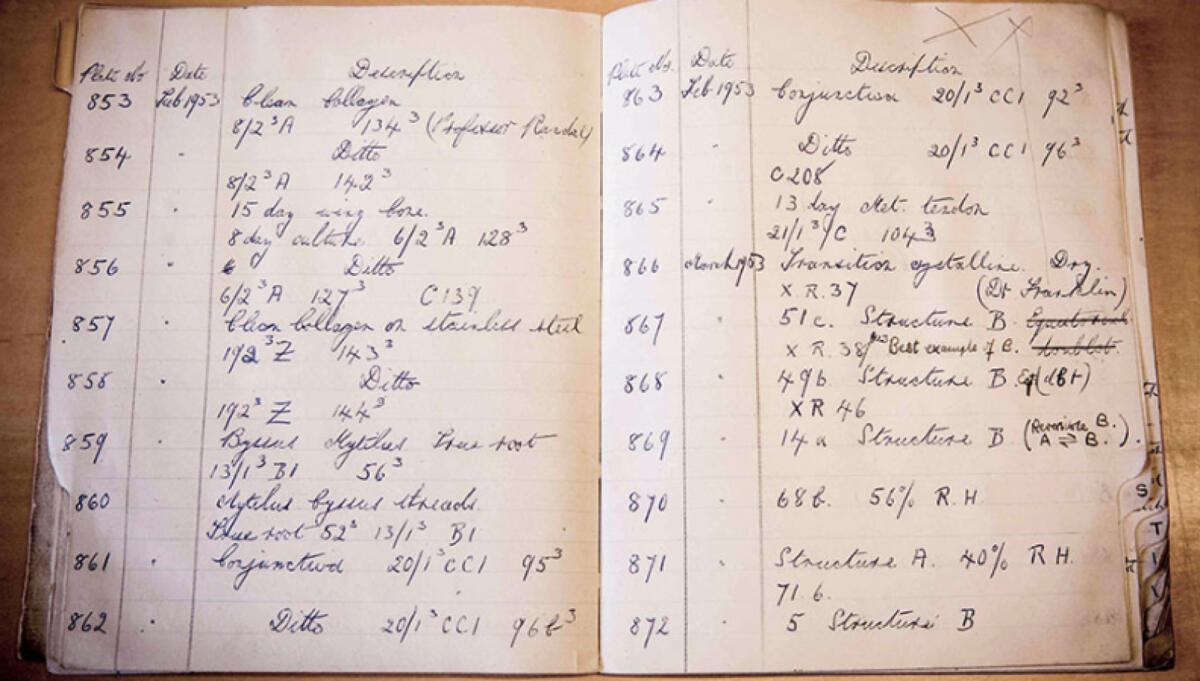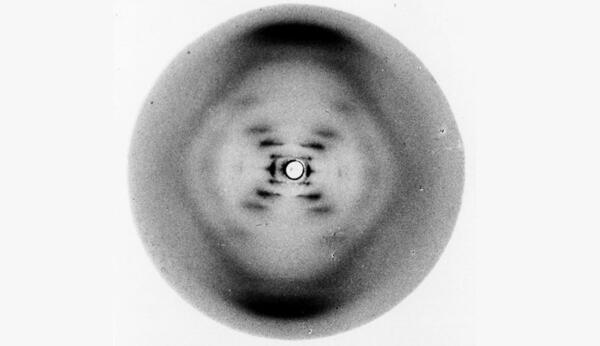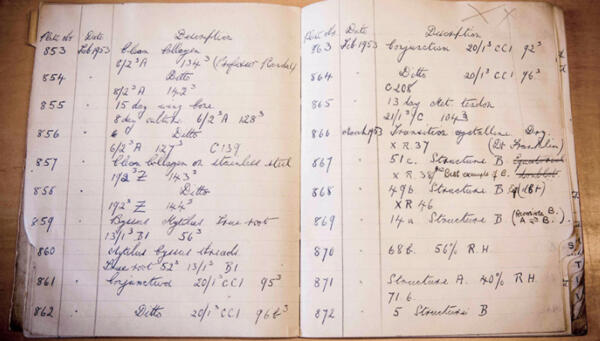Photograph 51 | Extras
Photograph 51– Glossary
A glossary of terms for the Michael Grandage Company production of Photograph 51 by Anna Ziegler. Compiled by Associate Director John Haidar for rehearsals.

‘A’ Form
Unhydrated configuration of the DNA molecule.
Adenine
Compound, derived from purine; one of the four constituent bases of nucleic acids.
Anti-Parallel
Parallel, but moving in opposite directions.
Atom
The smallest particle of a chemical element that can exist.
‘B’ Form
Hydrated configuration of the DNA molecule, as seen in ‘Photograph 51’.
Base
Molecular substance that will neutralise an acid, but that does not dissolve in water.
Chromosome
Thread-like structure of nucleic acids and proteins found inside the nucleus of most living cells, carrying information in the form of genes.
Crystallography
Branch of science concerned with the structure and properties of crystals.
Cyclotron
Accelerator in which charged sub-atomic particles are propelled in spiralling paths by the use of a constant magnetic field.
Cytosine
Pyrimidine derivative compound; one of the four constituent bases of nucleic acids.
DNA
Deoxyribonucleic acid: a self-replicating material that is present in living organisms as the principal constituent of chromosomes and the carrier of genetic information.
Docket
List of things to do.
Gene
(Informal term for) a unit of heredity that is transferred from a parent to offspring and is held to determine the inherited characteristic(s).
Helix
An object having a three-dimensional shape like that of a wire wound uniformly in a single layer around a cylinder, as in a spiral staircase.
Hemoglobin
Red protein responsible for transporting oxygen in the bloodstream.
High Dudgeon
Feeling of intense indignation.
George Washington
1732-1799. Commander-in-Chief of the Continental Army in the American War of Independence (1775-1783) and first President of the United States (1789-1797).
Guanine
Pyrimidine derivative compound; one of the four constituent bases of nucleic acids.
Isomorphous Replacement
Replacement of complex molecules in a crystalline structure by less complex ones, usually a heavy metal. Although the chemical make-up changes, its crystal form does not. As such, it may be possible to decipher its inner workings via X-ray diffraction.
J.T. Randall
1905-1984. British physicist and biophysicist, credited with radical improvement of the cavity magnetron, an essential component of radar and, as such, a key to Allied victory in World War II; Head of Physics at King’s College London (1946-1970).
Lawrence Bragg
1890-1971. Australian-born British physicist and X-ray crystallographer; discoverer of the Bragg Law of X-ray diffraction in 1912; along with his father, he was awarded the Nobel Prize in Physics in 1915; Cavendish Professor of Physics (1938-1953).
Linus Pauling
1901-1994. One of the founders of the study of quantum chemistry and molecular biology; awarded the Nobel Prize in Chemistry in 1954 and the Nobel Peace Prize in 1962; Chairman of the Division of Chemistry and Chemical Engineering at Caltech (1936-1958).
Ludo
Simple board game in which players move counters by throwing dice.
Macromolecule
Molecule containing a very large number of atoms.
Manhattan Project
US government-led research and development project – 1942-1945 – producing the first nuclear weapons during World War Two, including those dropped on Hiroshima and Nagasaki.
Molecule
A group of atoms bonded together, representing the smallest fundamental unit of a chemical compound that can take part in a chemical reaction.
Monomeric
Single molecule, capable of combining with other molecules.
Nucleic Acid
Complex organic substance present in living cells, such as DNA, whose molecules consist of many nucleotides linked in a long chain.
Nucleotide
Compound consisting of a nucleoside linked to a phosphate.
Optics
Scientific study of sight and the behaviour of light, or the properties of transmission and deflection of other forms of radiation.
Pandosto
Prose romance written by English author, Robert Greene, in 1588. Greene, in turn, may have based the work upon Geoffrey Chaucer’s The Clerk’s Tale. Greene’s story contains darker elements – Pandosto commits suicide out of grief after causing the death of his son and wife and falling in love with his daughter – which Shakespeare lightened for his comic purposes in The Winter’s Tale.
Phoenix
West End theatre located on Charing Cross Road (opened on 24th September 1930).
Phosphate
Organic compound of phosphoric acid in which the acid is bound to nitrogen in a way that permits useful energy to be released, as in metabolism.
Protein
Nitrogen-based organic compound consisting of a large molecule composed of long chains of amino acids; an essential part of living organisms, especially as structural components of bodily tissues, e.g. muscle, hair, collagen, enzymes, and antibodies.
Purine
A double-ringed, colourless, crystalline ‘parent’ compound of the nitrogen bases, adenine and guanine, which may be derived from it.
Pyrimidine
A single-ringed, colourless, crystalline ‘parent’ compound of the nitrogen bases, cytosine and thymine, which may be derived from it.
Signer DNA
Rudolf Signer’s high-quality extraction of DNA from a calf thymus gland, collected in 1950, and distributed after a meeting at the Faraday Society to those researchers, including Maurice Wilkins, who expressed an interest.
Storgalten
3,742 ft (1,141 m) mountain peak in the Norwegian Alps.
Tantalus
Phrygian King from classical mythology condemned to remain in the underworld, chin-deep in water, with fruit-laden branches hanging above his head: whenever he tried to drink or eat, the water and fruit receded out of reach.
Temerity
Excessive confidence or boldness; audacity.
Thymine
Compound, derived from purine; one of the four constituent bases of nucleic acids.
Tobacco Mosaic Virus
Single-stranded RNA virus occurring worldwide that causes disease in plants, such as tobacco and tomato, especially of the nightshade family.
‘Vous me flattez plus que je ne mérite’
(French) ‘You flatter me more than I deserve.’
X-Ray Diffraction
Scattering of X-rays by the regularly-spaced molecular structure of a crystal; useful in deciphering information about the structure of the crystal.



